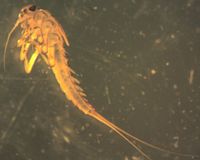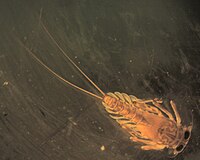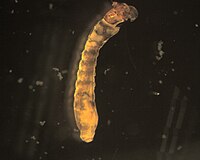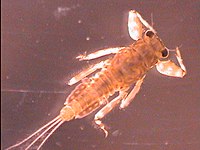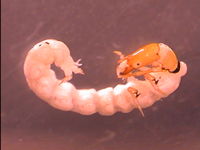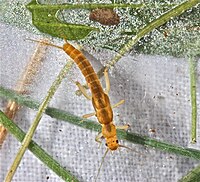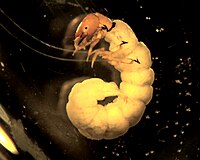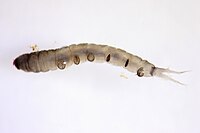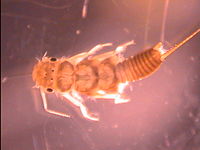Baldwin Creek
From WikiEducator
| Stream code: | OC_BldwnCrk_1026 |
| Basin: | Otter Creek |
| State or Province: | Vermont |
| Country: | USA |
| Latitude: | 44.16231878 |
| Longitude: | -73.01806138 |
| School: | Mount Abraham Union High School |
The following are the most common invertebrates collected from this stream site.
Contents
Baetis
- Order
- Ephemeroptera
- Family
- Baetidae
- Genus
- Baetis
- Common name
- The Little Olive
- Tied fly
- Sawyer Pheasant Tail Nymph
This mayfly has three "tails" and a unique head shape. Its gills are oval shaped and insert dorsally. More mature nymphs have long, dark wing pads.
Image of the long, dark wing pads.
Epeorus
- Order
- Ephemeroptera
- Family
- Heptageniidae
- Genus
- Epeorus
- Common name
- The Quill Gordon
- Tied fly
- Quill Gordon
This is the only Heptageniidae genus present in this area with two tails!
Chironomidae
Midge larvae tend to be the most common macroinvertebrate at our sites. As with other Diptera, there are no true jointed legs. Chironomidae do have a pair of prolegs at each end and preserved individuals tend to curl into a 'C'. Identification past family requires slide-mounted heads. We have seen philopotamid caddisflies misidentified with the chironomids and we suspect that that happens when samples are being sorted from trays. Under a microscope, six prominent legs can be seen on members of the caddisfly family Philopotamidae.
More information on Philopotamidae.
Simuliidae
Simuliidae appear rather like bowling pins with heads. Relatively speaking, we collect few members of this family and have we have not identified them past family at this point.
Click here for a close up image of the heads.
Drunella
The mayfly Drunella is distinguished by its large femoral “biceps;” these femora have tubercles on the leading margins. Gills are present on segments 3-7.
Chimarra
Chimarra are distinguished from the other Philopotamidae by a prominent asymmetrical notch in the frontoclypeus as well as a prominent process on the femur which bears a single hair (seta).
Images of the asymmetrical notch and prominent process.
Leuctra
This family of stonefly is fairly slender by stonefly standards. The divergent wing pads are a helpful characteristic. Leuctridae are similar in overall shape to the Capniidae; however, Leuctridae often do not have pleural folds. If they are present, they only extend from abdominal segments 1-7. Leuctra are recognized by abdominal terga with posterior fringes of short hairs and last few segments with longer hairs.
Image of the divergent wing pads.
Dolophilodes
Dolophilodes stands out in the Philopotamidae family due to its slightly asymmetrical frontoclypeus on the anterior margin and its distinguishable projecting foretrochantin.
Images of the slightly asymmetrical frontoclypeus, and the projecting foretrochantin.
Antocha
This small dipteran in the cranefly family is quite common. It is distinguished from most other dipterans we found by the 'creeping welts' that appear as prominent dark stripes along the abdomen. The dark head is usually partly exposed; however, it can be pulled back into the thoracic cavity during preservation.
Acroneuria
Acroneuria are among the most common Perlid stoneflies that we find. The larvae have a close-set postocular fringe consisting of thick spinules. They have three ocelli, and a yellow m-shaped mark in front of the middle ocellus. The bases of their cerci have thick, silky setae.
The postocular fringe can be seen here. Look in front of the three ocelli for the yellow m-shaped mark. Focus where the cerci meet the body to see the thick, silky setae.

